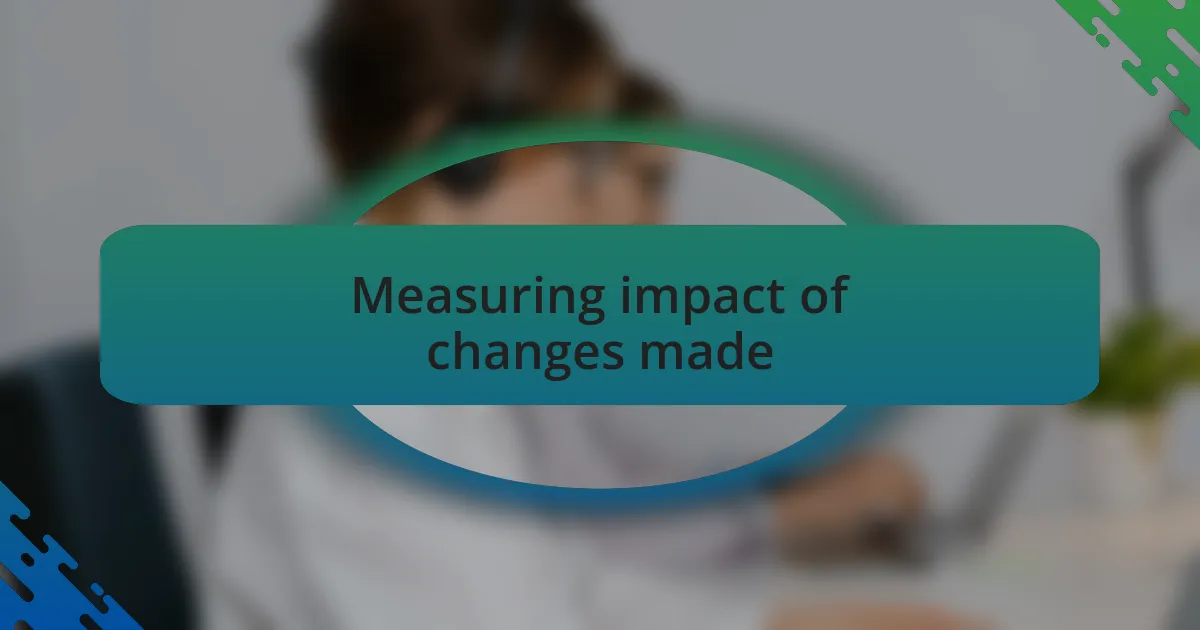Key takeaways:
- Heatmaps provide visual insights into user behavior, helping developers identify engagement patterns and improve designs for better functionality.
- Implementing changes based on heatmap analysis can significantly boost user engagement and conversions, emphasizing the importance of visibility and intuitive design.
- Measuring the impact of adjustments involves analyzing metrics alongside user feedback, revealing the narrative behind the data and highlighting user emotions.

Understanding heatmaps in software development
Heatmaps are a powerful tool in software development, providing visual representations of user behavior on our websites. I remember the first time I analyzed a heatmap for a project; it was like uncovering hidden patterns that directly influenced how I approached layout and design. Have you ever wondered why certain buttons get more clicks than others? Heatmaps help answer that question.
These visual aids highlight areas of high and low engagement, allowing developers to make informed decisions. I once worked on a software application where users frequently missed a vital call-to-action button. After implementing changes based on heatmap insights, I witnessed a noticeable increase in conversions. This experience taught me how crucial it is to pay attention to user interaction.
Understanding heatmaps doesn’t just help improve functionality; it fosters empathy for users. I often find myself asking, “What challenges are they facing?” Recognizing interactive patterns enhances our ability to create user-centered designs, ultimately leading to more successful software solutions.

How to generate heatmaps
To generate heatmaps effectively, I typically start by selecting the right tool for the job. There are numerous heatmap generators available, each offering unique features. In my experience, tools like Hotjar and Crazy Egg have provided comprehensive insights into user behavior, making them go-to options for my projects.
Once I choose a tool, I integrate it into the website seamlessly. This often involves adding a small piece of tracking code to the site’s backend—a task that, fortunately, is usually quick and straightforward. One time, I was hesitant about the technical setup, but I quickly realized that investing a little time set me on the path to significant user insights.
After implementation, I focus on defining the parameters I want to analyze, such as the target pages and the timeframe for data collection. It’s fascinating to watch how user interactions evolve over time. I often find myself pausing to reflect: what story are these clicks telling me? Each heatmap I analyze offers a new chapter in understanding user engagement, driving home the importance of continuous improvement.

Analyzing heatmap data effectively
Once I start analyzing heatmap data, I dive into the sections that draw the most attention. It’s always a revelation to see where users are clicking the most—and where they completely ignore. I remember a project where a crucial call-to-action button barely registered any clicks, which made me question if it was placed appropriately or if the design was off. That insight propelled me to redesign the button’s color and positioning, which ultimately boosted engagement.
When I sift through the data, I look at patterns that emerge over time. Observing these trends helps me understand shifting user behavior. For example, after running a heatmap for several weeks, I noticed that users were increasingly drawn to a specific feature. This pattern led me to investigate further through user feedback sessions. Have you ever thought about how a moment’s observation can lead to significant changes? In my experience, these small adjustments can result in improved user satisfaction.
Another essential part of my analysis is comparing heatmaps from different timeframes or user segments. Doing this not only reveals comprehensive insights but also allows me to tailor content and features to specific audiences. I recall a time when analyzing heatmaps for mobile users showed vastly different engagement compared to desktop users. Each user segment tells a unique story, and recognizing these differences empowers me to make smarter decisions for everyone who interacts with my website.

Implementing changes based on heatmaps
When it comes to implementing changes based on heatmaps, I always start with the most glaring insights. For instance, I once discovered that a key section of a landing page, designed to be the focal point, was virtually overlooked. It tugged at my attention; I wondered how many potential leads were slipping through the cracks. So, I shifted that element towards the top of the page and adjusted its design to be more eye-catching. The moment I made those changes, I noticed a significant uptick in user engagement—turns out, visibility truly matters.
Another time, I found myself grappling with a feature that users seemed to find confusing, despite its apparent utility. Diving deeper into the heatmap data, I realized that users were hovering extensively but not clicking through. This sparked an idea: what if I streamlined the process and added tooltips to guide users? It was a leap of faith, but those minor adjustments—like creating a smoother user experience—transformed how visitors interacted with that feature. Have you ever felt the satisfaction of watching a once-neglected tool become a favored part of your site? It’s a rewarding journey to see theory translate into tangible success.
I believe experimentation is key to growth, especially when implementing changes. I remember a time after adjusting the placement of various elements based on heatmap data. The initial results were promising, but I wasn’t one to settle. Instead, I conducted A/B tests to see which configurations worked best. This approach allowed me to fine-tune my decisions further—leading not only to a better conversion rate but also revealing the evolving preferences of the audience. Isn’t it fascinating how user behavior can be both unpredictable and insightful? It keeps me eager to keep testing and learning, ensuring that every change is a step towards enhanced user satisfaction.

Measuring impact of changes made
Measuring the impact of changes made is crucial in understanding how effectively your adjustments resonate with users. After implementing several tweaks based on heatmap insights, I found myself closely monitoring the analytics dashboard. One day, I was pleasantly surprised to see metrics soar—what a thrill! It’s a bit like opening a gift; the moment you peel back the layers of the data, you wonder, “Did this really work?” The answer became abundantly clear. It validated that the effort put into refining the user experience truly paid off.
Later on, I took it a step further by connecting user feedback with my heatmap findings. I distinctly remember hosting a small user interview session to gather qualitative data. The comments I received were eye-opening. Users highlighted how the changes made them feel more guided and engaged. This interplay between hard data and human experience is invaluable—how often do we get to pair numbers with emotions? It’s these stories that flesh out the numbers and give depth to the analytics.
Most importantly, I learned that measuring impact isn’t just about examining numbers; it’s about understanding the narrative behind those numbers. I recall adjusting the call-to-action button’s color and seeing a notable rise in clicks. At first glance, the change seemed minor, yet the results were anything but. Listening to user actions and emotions taught me that sometimes the smallest adjustments can lead to the biggest transformations. Isn’t it amazing how an empathetic approach can turn mere data into meaningful connection?